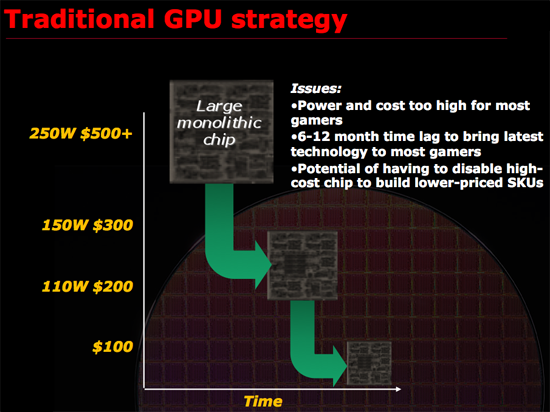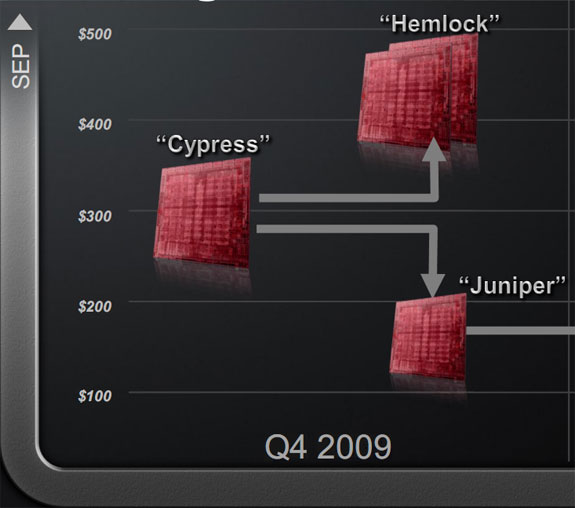The RV870 Story: AMD Showing up to the Fight
by Anand Lal Shimpi on February 14, 2010 12:00 AM EST- Posted in
- GPUs
What Made it All Ok: 4 GPUs in < 6 Months
Through a lot of hard work and sacrifice, even on Carrell’s part, ATI cut the RV870 from as much as 22mm on a side down to roughly 18mm x 18mm. The problem is that RV770 was around 16mm on a side. The RV870 was still too big.
Carrell wanted to cut it down even more, but two things changed his mind. First, in order to build 870 in the space of a 770 ATI would have to cut out much more from the chip than Carrell originally tought. One of the things that would have to go was some of the shader core.
In order to run the GDDR5 memory at the sort of data rates that ATI was targeting for the 5870 the analog PHYs on the chip had to grow considerably. At 16mm on a side ATI would either have to scale back memory bandwidth or eat into the shader core area. Either way we would’ve had a slower chip.
I asked Carrell if 16mm on a side would’ve made the RV870 $100 cheaper at launch, putting it on par with the RV770 launch prices. He said no. I didn’t find out why until much later, but I’ll save that story for another time.
Sacrificing performance to meet the 16mm x 16mm die size targets wasn’t going to happen, but what ultimately convinced Carrell to go with a larger die this time around was something that ATI didn’t get nearly enough praise for: the ability to launch 4 different 40nm DirectX 11 GPUs in less than 6 months.
Remember that Carrell’s beef with building the biggest GPU possible is that it takes too long for the majority of customers to get access to derivatives of that GPU. Look at how long it took G80 or GT200 to scale down. And who knows when we’ll see $150 Fermi/GF100 derivatives.

But ATI Engineering promised two things. First, that Cypress would have a successor called Juniper that would be ready around the same time. Secondly, two more GPUs would follow and the whole stack will be done and out in less than 6 months. ATI came close in 2008 with 3 GPUs in 3 months, but the fourth member of the 4000 series didn’t show up until April of 2009.
It wasn’t an impossible feat. ATI does have concurrent design teams and a lot of engineering resources in India/China. By working on Juniper in tandem with Cypress, assuming there were no show stopping bugs, ATI could exploit efficiencies in two teams effectively working on the same hardware (Juniper was just half a Cypress).
The idea of taking such a huge risk made Carrell uncomfortable. Running two GPU designs in parallel, for the same family of chips, is risky. If everything works out perfectly, you get two chips out at the same time. If it doesn’t, you’ve just tied up two design teams on one product generation. A slip here would give ATI its own Fermi.
What ultimately sold Carrell was the fact that engineering told him that they believed they could pull it off. Carrell believes in people. He believes if you expect the best out of those around you, then that’s what you’ll get. He couldn’t reconcile his beliefs with doubting the schedule engineering was feeding him. Carrell nervously signed off and the Evergreen stack was born.

Cypress and Juniper were delivered nearly at the same time. In fact, Juniper was ready a bit earlier and was sampled to developers months before ATI launched the 5000 series. Cedar and Redwood followed, not to mention a dual-Cypress board that became the Radeon HD 5970. And all of this was done and ready in less than 6 months (the chips themselves were all ready within 4 months).
When the smoke cleared ATI had new DirectX 11 parts at $600, $400, $300, $200, $150, $100 and $60. The Windows 7/DirectX 11 market bulge just got serviced.










132 Comments
View All Comments
ThomasS31 - Monday, February 15, 2010 - link
...it would be very interesting if nVidia tell us the story openly, what happened with this long delayed newly designed chip.Anand staff, please try and persuade them to tell all details! :)
XiZeL - Monday, February 15, 2010 - link
dont want to look like a fanboy here but these stories just make me like ATI even more, make me feel like part of the familiy...why dont you guys ever write these about nVidia?
Anand Lal Shimpi - Monday, February 15, 2010 - link
The only reason I'm able to write something like this is because of how open/honest/unmarkety Carrell Killebrew is. And how trusting AMD PR is that they allow me to talk to him without any sort of limitations in place.Until recently, there hasn't been a similar contact for me at NVIDIA. That has changed in the past few months and I've already reached out to him to see if he is willing to allow me the same opportunity to talk about Fermi.
If I can make it happen, I will :)
Take care,
Anand
XiZeL - Tuesday, February 16, 2010 - link
thanks for the reply :)just for the record, as a costumer and someone who really likes technology, these kind of articles will help me take my final descision when bying a product...
yeally looking forward to seeing the same from Nvidia and try to understand their aproach on building a chip :)
thanks again
Mat3 - Monday, February 15, 2010 - link
I really enjoy reading stuff like this. One request for the next time you're talking to ATI guys: can you ask them about Fast14 and why it didn't work for them?Iketh - Monday, February 15, 2010 - link
6900 series = Pagan6800 series = Sarigan
6700 series = Saipan
6600/5500 series = Tinian
6400 series = Rota
Im probably way off lol
hyvonen - Monday, February 15, 2010 - link
Leaker! You'll be reported.XtremeOne - Monday, February 15, 2010 - link
Thank You for this beautiful and insightful article. Like many before me, i registered just to say that. Anandtech is one of the sites I fell very lucky to know about. Some of your articles are a bit "techie" for me, but this one is practically impossible to stop reading. :D Thank you Anand.Iketh - Monday, February 15, 2010 - link
it's a shame there cant be more articles like this... having a close relationship with one company allows it every year or two, but there are many companies in this field which could produce many more stories... i feel Anand is slowly tapping into a gold minejstall - Monday, February 15, 2010 - link
This is a fantastic article, nice to get some insight into the the RD and thought process just as much as it is to see performance charts. Be nice to see a little more of this.